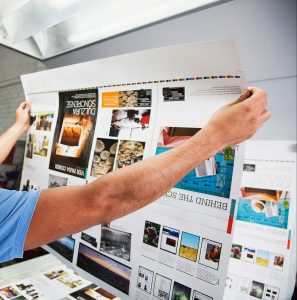Print production is a multifaceted process that involves several crucial stages, each playing a pivotal role in the creation of high-quality printed materials. From the initial conception to the final finishing touches, understanding these key points is essential for ensuring successful print production.
Concept: You’ve Got an Idea!
The concept stage marks the beginning of the print production process. It involves ideation, planning, and design. It sets the foundation for the entire process and ensures the design concept is well-defined, aligned with the project goals, and addresses potential challenges early on.
Ideation and Briefing: Determining the purpose of the print material, target audience, desired outcomes, and any specific design or branding guidelines.
Design and Layout: Selecting appropriate typography, colors, images, and graphics that align with the client’s brand identity and intended message. Sketches, mock-ups, or digital prototypes, help stakeholders visualize and evaluate the design concept.
Prepress Preparation: File optimization, color correction, image retouching, and converting the design into a print-ready format.
Paper Selection: Selecting the best paper type, weight, and finish is crucial for achieving the desired look and feel of the printed material.
RELATED: EMBELLISHMENTS: HOW TO DRESS UP YOUR PRINT MATERIALS
Production: Bringing an Idea to Life
Bridging the gap between imagination and reality, it is during this stage that the vision and creativity of the initial concept come to life. This stage involves implementing various technical processes, such as color calibration, image resolution optimization, and precise printing techniques, to accurately reproduce the design on the chosen print medium.
Prepress Proofing: Proofs are created to ensure that the final output will meet the desired quality standards and allow for final adjustments.
Printing Techniques: Utilizing the appropriate printing method ensures that the final printed product meets the desired quality standards, cost-efficiency, and specific requirements of the project.
Quality Control: Calibrated monitors, standardized color profiles, and color-proofing systems, are employed to achieve consistent and accurate color reproduction.
RELATED: SOLVE YOUR PRINT PROBLEMS WITH DIGITAL PRINTING
Finishing: The Final Product
The finishing stage ensures that the printed materials are complete, professional, and ready to make a lasting impact on the audience. These finishing techniques enhance the visual appeal of the materials and contribute to their longevity and usability.
RELATED: FINISH STRONG: PRINT FINISHING TECHNIQUES THAT WOW
Binding and Folding: Various binding methods like saddle stitching or perfect binding may be employed. Folding techniques are utilized for brochures, pamphlets, or leaflets to create organized and visually appealing layouts.
Cutting and Trimming: Precision cutting and trimming are crucial to ensure uniformity and accuracy in the final product. Cutting machines equipped with automated systems help achieve clean and precise cuts, maintaining the desired dimensions.
Coating and Lamination: Used to protect the printed material, enhance its durability, and improve its visual appeal. Options include matte or glossy coatings, spot varnishes, or laminating films that provide a protective layer that increases the longevity of your printed materials.
Quality Inspection: Before the printed materials are packaged and delivered, a thorough quality inspection is conducted to identify any defects, errors, or inconsistencies.
Print Questions? Ironmark Has You Covered
From the conception stage to the finishing stage, attention to detail and quality control are paramount. By understanding and optimizing these three pivotal points in the process, you can ensure the creation of outstanding printed materials that effectively communicate your message. If you’ve got questions, we can help! Reach out to our expert print team to get you started on your next project today!




